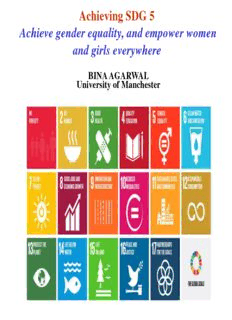
Bina Agarwal PDF
Preview Bina Agarwal
Achieving SDG 5 Achieve gender equality, and empower women and girls everywhere BINA AGARWAL Un iversity of Manchester Target 5a 5.6a Ensure women’s access and control over land and other property ___________________________ This goal/target is key to women’s economic, social, political empowerment This target also has synergy with many other goals • 1 Poverty • 2. Hunger • 3 Health • 4 Education • 5.2: violence against women Economic empowerment: Land » Secure livelihoods, food security, reduced hunger (goal 2 & 5) Secure Livelihoods: Agriculture is main source of livelihood for 67% of rural population & 69% of poor in India But women more dependent: 75% of rural women vs 60% men depend on agriculturit for livelihood. Land is key factor of production. Also feminisation of agriculture. 35-39% agri workers are female. Women farmers have key role in cty’s production Improve food security, reduce hunger: • Land in women’s hands will improve intra-hh access to resources for better nutrition • increase women’s ability to grow food/increase incomes FAO State Of Food & Agriculture Report 2011 • Reducing the constraints women farmers face could raise their yields by 20-30% • Will also raise country’s agricultural growth rate Economic empowerment Land » Reduce risk of poverty (goals 1 & 5) Lack of immovable assets (agricultural land, homesteads), is linked with higher risks of poverty among HHs. But risk is much greater for women and children due to intra-household inequalities in distribution of resources for nutrition, health care, education, and so on. Also women without immovable assets can face poverty and destitution even in well-off households, in case of marital breakup. Immovable assets in women’s hands can help alleviate both HH poverty & intergenerational poverty. Land » enhance children’s health and education (synergy with goals 3 and 4) ________________________ Substantial Evidence: Assets (e.g. land) in the mother’s hands are found significantly more likely to improve child survival, nutrition and health outcomes than assets in father’s hands. Land » Social empowerment 5.2 Eliminate violence against women Evidence: Ownership of land and house greatly reduces women’s risk of domestic violence In turn, this will improve their health, ability to work outside home, & participate in public institutions. Employment alone (barring formal employment) does not provide this protection 5.2 Eliminate violence against women Example: Women’s property status and spousal violence, Kerala Women’s property Women facing long- status term physical violence Propertyless women 49 % Land owners only 18 % House owners only 10 % House & Land 7 % owners Source: B. Agarwal and P. Panda (2007): ‘Toward Freedom from Domestic Violence’, Journal of Human Development. 7 MEASUREMENT High gender inequality • Small surveys show high gender inequality: only about 10% rural women in NW India and 20% in S. India own land • No comprehensive data on women’s land ownership • Neither Agricultural census nor NSSO collect any gender disaggregated data on land ownership • Agricultural census gives gender data on operational holdings, and only by HH head. No information on intra-HH distribution in Male headed HHs • Same is true for home ownership Bina Agarwal 2017 OPERATIONAL HOLDINGS % Holdings by women % Area operated by women <10% <10% > 10 - < 15% > 10 - < 15% > 15 - < 20% > 15 - < 20% > 20% > 20% Women: 12.8% operational holdings, 10.4% operated area, mainly in South. FHH=0.93 ha MHH=1.18 ha Agricultural census of India, 2010-11 POLICIES AND DATA • We need policies to reduce gender inequalities in land and house ownership, • We need gendered data to monitor changes
Description: